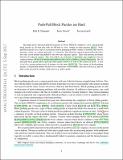| dc.contributor.author | Demaine, Erik D | |
| dc.contributor.author | Grosof, Isaac B. | |
| dc.contributor.author | Lynch, Jayson R. | |
| dc.date.accessioned | 2019-06-13T19:10:30Z | |
| dc.date.available | 2019-06-13T19:10:30Z | |
| dc.date.issued | 2017-04 | |
| dc.identifier.issn | 0302-9743 | |
| dc.identifier.issn | 1611-3349 | |
| dc.identifier.issn | 978-3-319-57585-8 | |
| dc.identifier.issn | 978-3-319-57586-5 | |
| dc.identifier.uri | https://hdl.handle.net/1721.1/121270 | |
| dc.description.abstract | This paper proves that push-pull block puzzles in 3D are PSPACE-complete to solve, and push-pull block puzzles in 2D with thin walls are NP-hard to solve, settling an open question [19]. Push-pull block puzzles are a type of recreational motion planning problem, similar to Sokoban, that involve moving a ‘robot’ on a square grid with 1 × 1 obstacles. The obstacles cannot be traversed by the robot, but some can be pushed and pulled by the robot into adjacent squares. Thin walls prevent movement between two adjacent squares. This work follows in a long line of algorithms and complexity work on similar problems [3– 9, 14, 16, 18]. The 2D push-pull block puzzle shows up in the video games Pukoban as well as The Legend of Zelda: A Link to the Past, giving another proof of hardness for the latter [2]. This variant of block-pushing puzzles is of particular interest because of its connections to reversibility, since any action (e.g., push or pull) can be inverted by another valid action (e.g., pull or push). | en_US |
| dc.language.iso | en | |
| dc.publisher | Springer International Publishing | en_US |
| dc.relation.isversionof | http://dx.doi.org/10.1007/978-3-319-57586-5_16 | en_US |
| dc.rights | Creative Commons Attribution-Noncommercial-Share Alike | en_US |
| dc.rights.uri | http://creativecommons.org/licenses/by-nc-sa/4.0/ | en_US |
| dc.source | arXiv | en_US |
| dc.title | Push-Pull Block Puzzles are Hard | en_US |
| dc.type | Article | en_US |
| dc.identifier.citation | Demaine, Eric D. et al. "Push-Pull Block Puzzles are Hard." CIAC 2017: Algorithms and Complexity, May 2017, Athens, Greece, Springer International Publishing, June 2017 © 2017 Springer International Publishing | en_US |
| dc.contributor.department | Massachusetts Institute of Technology. Computer Science and Artificial Intelligence Laboratory | en_US |
| dc.contributor.department | Massachusetts Institute of Technology. Department of Electrical Engineering and Computer Science | en_US |
| dc.relation.journal | CIAC 2017: Algorithms and Complexity | en_US |
| dc.eprint.version | Author's final manuscript | en_US |
| dc.type.uri | http://purl.org/eprint/type/ConferencePaper | en_US |
| eprint.status | http://purl.org/eprint/status/NonPeerReviewed | en_US |
| dc.date.updated | 2019-06-12T13:21:10Z | |
| dspace.date.submission | 2019-06-12T13:21:11Z | |
